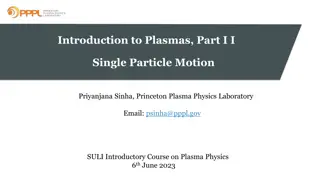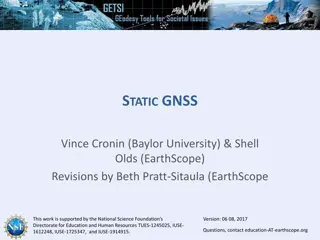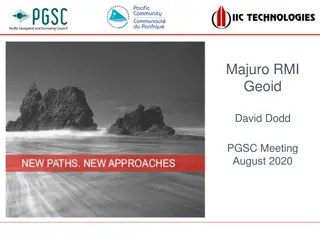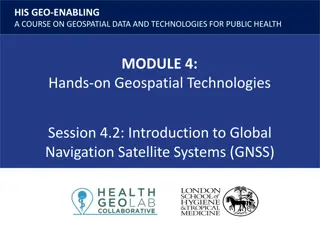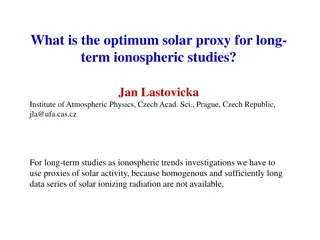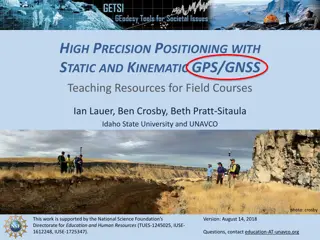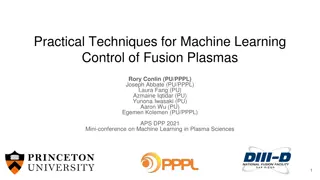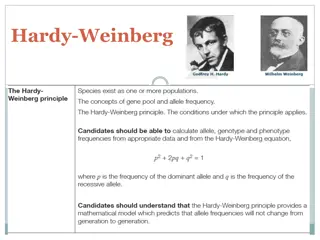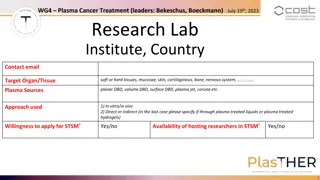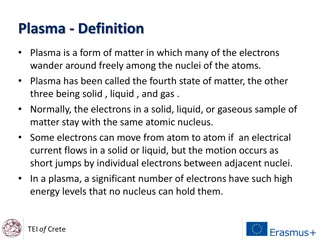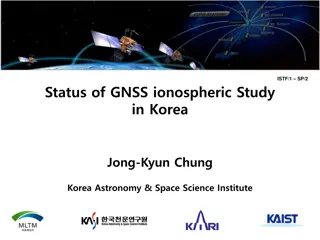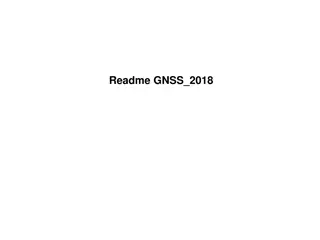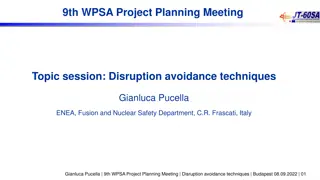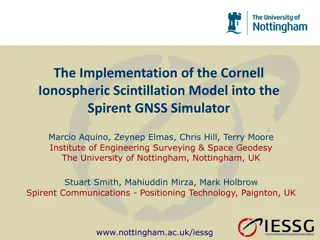Estimation of Ionospheric Critical Plasma Frequencies Using GNSS Measurements
This research focuses on estimating the critical plasma frequency of the ionosphere, specifically the F2 layer (f0F2), using GNSS measurements. The study reviews past work on ionospheric modeling, discusses neural network training inputs, and presents a single station neural network model (NNT2F2). The model offers a way to estimate f0F2 values globally based on GNSS TEC measurements. The research addresses the relevance of f0F2, its measurement methods, equipment availability, and alternative ways of estimation. The study highlights limitations of existing models and proposes a more precise approach for estimating ionospheric parameters.
Download Presentation

Please find below an Image/Link to download the presentation.
The content on the website is provided AS IS for your information and personal use only. It may not be sold, licensed, or shared on other websites without obtaining consent from the author.If you encounter any issues during the download, it is possible that the publisher has removed the file from their server.
You are allowed to download the files provided on this website for personal or commercial use, subject to the condition that they are used lawfully. All files are the property of their respective owners.
The content on the website is provided AS IS for your information and personal use only. It may not be sold, licensed, or shared on other websites without obtaining consent from the author.
E N D
Presentation Transcript
E S T I M AT I O N O F I O N O S P H E R I C E S T I M AT I O N O F I O N O S P H E R I C C R I T I C A L P L A S M A C R I T I C A L P L A S M A F R E Q U E N C I E S F R O M G N S S F R E Q U E N C I E S F R O M G N S S - - T E C M E A S U R E M E N T S U S I N G M E A S U R E M E N T S U S I N G A R T I F I C I A L N E U R A L A R T I F I C I A L N E U R A L N E T W O R K S N E T W O R K S T E C OTUGO VIVIAN International colloquim on equatorial and low- latitude ionosphere, Lagos, 2019
OUTLINE CONTD PROBLEM STATEMENT REVIEW OF PAST WORK ON IONOSPHERIC MODELLING DATA AND METHODS NEURAL NETWORK TRAINING INPUTS FOR THE NEURAL NETWORK RESULTS AND DISCUSSION SINGLE STATION NNT2F2 MODEL DISCUSION AND CONCLUSION International colloquim on equatorial and low- latitude ionosphere, Lagos, 2019
. International colloquim on equatorial and low- latitude ionosphere, Lagos, 2019
THE PROBLEM STATEMENT What is Ionospheric Critical Frequency of the F2 layer (f0F2)? What is the relevance? How can it be measured? Is the equipment readily available? What is the alternative way? International colloquim on equatorial and low- latitude ionosphere, Lagos, 2019
PREVIOUS RESEARCH Past studies have established a correlation between f0F2 and TEC (Spalla and Cirallo,1994, Malteseva and Mozhaseva, 2016, Wijaya et al, 2017). The International Reference Ionosphere (IRI) model, a recognized and recommended model has been widely applied for the prediction of ionospheric parameters. However, this model is deficient in its inability to predict ionospheric data precisely; during both disturbed and quiet conditions (Okoh et al., 2012, Bilitza et al., 2011, Nakura et al.,2007). Earlier research by Spalla and Cairolo (1994) proposed a very straight forward model described in equation (1). (?0?2)2= 3.51 ??? (1) However, this model can only give a coarse approximation of f0F2 median values (Sessanga et al., 2014). International colloquim on equatorial and low- latitude ionosphere, Lagos, 2019
PREVIOUS RESEARCH Ssessenga et al (2014), estimated the critical frequency f0F2 values using Regression method, however; their study covered only stations in South Africa. A recent work by Athieno et al;2017 developed a neural network model for a single station using f0f2 data. We used 52- pair ionosonde- GNSS data spanning from 2000 -2016 (17 years) to develop a neural network based model( NNT2F2 model) that can estimate f0F2 from GNSS TEC measurements. NNT2F2 model offers a computer program, that can be used with a GNSS receiver to estimate f0F2 values at any location in the world. International colloquim on equatorial and low- latitude ionosphere, Lagos, 2019
SOURCES OF DATA f0F2 data: Ionosonde observations of f0F2 values were obtained from the archives of the Space Physics Interactive Data Resources (SPIDR, http://spidr.ngdc.noaa.gov/spidr), and from the South African National Space Agency (SANSA) Space Science. TEC data: GNSS data were obtained online from data archives of the University of California, San Diego (www.garner.uscd.edu), and from the South African network of continuously operating GNSS base stations (TRIGNET, http://www.trignet.co.za). Sunspot and Dst data: We also obtained the hourly values of both the sunspot values and Dst (Disturbance storm Time) indices from the Space Physics Data Facility of the Goddard Space Flight Center, National Space Administration s omniweb (https://omniweb.gsfc.nasa.gov/form/dx1.html) International colloquim on equatorial and low- latitude ionosphere, Lagos, 2019
LOCATIONS OF IONOSONDE AND GNSS RECEIVER STATIONS USED IN THIS WORK. International colloquim on equatorial and low- latitude ionosphere, Lagos, 2019
METHOD OF ANALYSIS METHOD OF ANALYSIS Artificial Neural network ( neural network for short) is an inter connected assembly of simple processing elements, units or neurons; which is based on the neural configuration of the brain (Gurney; 2004, Kohli et al; 2014). Neural network trained with adequate historic data has been established to be an ideal method for the prediction of non- linear ionospheric parameters (Mckinnell and Poole; 2004, Habarulema et al.,2007, (e.g. Habarulema et al., 2009b, Maruyam, 2007, Pietrella and Petronne; 2008, Athieno et al.,2017). Neural networks are are sufficiently fast for real time processing (Wintoft and Cander, 2000) International colloquim on equatorial and low- latitude ionosphere, Lagos, 2019
NEURAL NETWORK TRAINING Neural networks can be trained using different algorithms. We used the Levenberg-Marquardt (LM) algorithm. The LM algorithm is designed to minimize the sum of square error functions that arise during neural network training Prior to training, the entire available data was randomly split into three sets: 70% for training, 15% for validation, and 15% for testing the neural networks implemented in this work constitute an input layer, a hidden layer, and an output layer International colloquim on equatorial and low- latitude ionosphere, Lagos, 2019
NEURAL NETWORK TRAINING The neural networks constitute of an input layer, a hidden layer, and an output layer ??= tanh(??? ??+ ?1) ??= tanh(??? ??+ ?2) ??, ??, and ?? are matrices which respectively contain the input layer neurons, the hidden layer neurons, and the output layer neurons. ??? and ??? are respectively the input and hidden layer weight matrices, (1.2a) (1.2b) while ?1and ?2 are respective bias vectors for the input and hidden layers. The matrices, ??, ??, and ?? are the variables in equations (1.2a) and (1.2b), while the weight matrices and bias vectors are constants in the equations. International colloquim on equatorial and low- latitude ionosphere, Lagos, 2019
METHODS OF ANALYSIS We first trained a system of single-station networks which have TEC as the only one input and f0F2 as the output. The number of hidden layer neurons was varied starting from 1 to 50 in steps of 1. For each of the 50 trained networks, we used the test dataset to compute the root-mean- square deviations (RMSDs) of the network predictions from the ionosonde measurements using the formula in equation below: n (Xi Pi)2 n i=1 1.3 RMSD = Where the Xi? and Pis are respectively the ionosonde observations and the neural network predictions, and n is the total number of observation-prediction pairs. International colloquim on equatorial and low- latitude ionosphere, Lagos, 2019
METHOD OF DATA ANALYSIS On the consideration that the relationship between f0F2 and TEC may vary depending on local time, season, and on the levels of solar and geomagnetic activities, we introduced more input layer neurons to investigate such dependencies. The following four parameters were used to represent the factors: the number of hours from local midnight of each day (for local time), the Julian number of days from the start of each year (for seasons), the sunspot number (SSN) (for level of solar activity), and the disturbance storm (Dst) index (for level of geomagnetic activity). International colloquim on equatorial and low- latitude ionosphere, Lagos, 2019
RMSDS FOR 5 DIFFERENT SYSTEMS OF NETWORKS TRAINED, ALL AVAILABLE DATA USED. International colloquim on equatorial and low- latitude ionosphere, Lagos, 2019
METHOD OF DATA ANALYSIS Based on the understanding that the observed insignificance of geomagnetic activity may actually be as a result of the fact that the data used for training and testing are predominantly quiet-time observations, we conducted a control experiment. For the control experiment, we first selected all observations that were recorded during geomagnetically disturbed periods (with Dst -50nT), and then randomly selected an equal amount of observations from the remaining data. .In this way, we had as much disturbed-time data as the quiet-time data International colloquim on equatorial and low- latitude ionosphere, Lagos, 2019
RMSDS FOR 5 DIFFERENT SYSTEMS OF NETWORKS TRAINED WITH 50% DISTURBED TIME DATA AND 50% QUIET TIME DATA. International colloquim on equatorial and low- latitude ionosphere, Lagos, 2019
RESULT OF THE SINGLE STATION MODELS International colloquim on equatorial and low- latitude ionosphere, Lagos, 2019
RESULTS OF THE SINGLE STATION MODELS International colloquim on equatorial and low- latitude ionosphere, Lagos, 2019
RESULT OF THE SINGLE STATION MODELS The results show that there are observable differences in the performances of the two models when used at either of the locations. The models perform more accurately at the stations for which they are developed than at the alternate stations. Conducting repeated tests using other stations showed that there were latitudinal and longitudinal differences in the relationships between f0F2 and TEC. The results motivated our inclusion of the station longitudes and latitudes as additional input neurons for the final neural network training used in the NNT2F2 model International colloquim on equatorial and low- latitude ionosphere, Lagos, 2019
DEVELOPING NNT2F2 MODEL Finally, the total number of input neurons for the final neural network was eight: TEC, DOYs, DOYc, SSN, LTs, LTc, latitude, and longitude. A total of 30 neural networks were trained in which the number of hidden layer neurons was varied from 1 to 30 in steps of 1. Each of the networks was then used to predict f0F2 values for the validation dataset, and the RMSDs were computed considering the corresponding ionosonde f0F2 values as references. International colloquim on equatorial and low- latitude ionosphere, Lagos, 2019
RMSDS FOR THE 30 DIFFERENT NEURAL NETWORKS TRAINED IN THE FINAL SYSTEM OF NEURAL NETWORKS ADOPTED IN THIS WORK. International colloquim on equatorial and low- latitude ionosphere, Lagos, 2019
RESULTS OF THE NNT2F2 MODEL International colloquim on equatorial and low- latitude ionosphere, Lagos, 2019
NNT2F2 MODEL PREDICTIONS IN COMPARISON WITH IONOSONDE MEASUREMENTS. International colloquim on equatorial and low- latitude ionosphere, Lagos, 2019
RESULTS OF THE NNT2F2 MODEL International colloquim on equatorial and low- latitude ionosphere, Lagos, 2019
CONCLUSION The relationship between f0F2 and TEC also vary with space, and the variation is less for closely located stations We showed that the relationship between f0F2 and TEC is not purely monotonic as suggested in certain previous works (e.g. Spalla and Cairolo, 1994), but that this relationship also depends on factors like the season, level of solar activity, and local time. This is the first paper in which neural networks have been used to study the relationship between f0F2 and TEC. The conducted error analysis indicates that the NNT2F2 model developed in this work can be used to estimate f0F2 values from GNSS-TEC measurements with accuracies of less than 1 MHz. International colloquim on equatorial and low- latitude ionosphere, Lagos, 2019
THANK YOU FOR LISTENING . International colloquim on equatorial and low- latitude ionosphere, Lagos, 2019


